This next post will cover the subject of warm sauces I would rather say that this is the first introduction to young cooks who would like to have a little bit of an idea regarding the subject of sauces that are served warm and accompany a dish.
my introduction to the subject includes several photos, most of which have been taken by my students and given to me from the years I used to teach in schools, and some were taken over the last couple of days in the restaurant either by one of my favorite photographers – Daniela Laila, or one of the chefs in the staff, including myself.
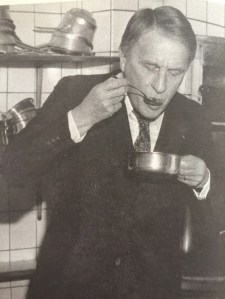
Marcel Kreusch one of Belgium top restaurateur in the 70 tastings one of Chef Basso’s sauces before lunch time
It is difficult to taste through an image, but you may certainly understand how a certain sauce can sit well on a dish. In fact, one of the worlds I have connected with most in the duration of my career is the world of sauce. The person that gave me the tools and the love for this world is the chef Attilio Basso, who was nicknamed by chefs from the big leagues as “Le Roi de Sauce” – the king of sauce. I had the privilege of being in his grasp for two full years and even they weren’t enough to learn everything.
These are the reasons I think a sauce is incredibly important and plays a vital role:
- A good sauce incorporates a world of rich flavors that can’t always necessarily be found in the main dish components (for example a good fillet steak by its own will become superior by a company of a great sauce.
- A good sauce adds aesthetic to the dish and many times will add a nice frame to the dish.
- Sauce often “saves” a dish that is slightly dry or was improperly prepared- still try to cook a great dish with a great sauce, don’t get used to a good sauce saving you.
- A good sauce may be used for dipping / wiping with bread at the end of a meal or “help” finish the meal with a light addition such as a potato puree usually does, something that usually gives a very fulfilling dining experience
What are the parameters of a good sauce in my point of view?
- The sauce must suit the dish – in color, texture, and of course, the combination of flavor – notice the photos attached (my work over different periods of time), they are meant to display the modification to the sauce in accordance with the colors and the layout of the food.
- A good consistency that goes well with the dish – there’s no iron-clad rule for this. The sauce may be prepared denser or more diluted, but there is one culinary term that comes up over and over again in cooking schools and in restaurants, and that is –” nape”. What is the definition of this term? That the sauce fills a spoon to the brim once dipped inside. Almost every time, this is a clear sign of a sauce with a successful consistency.
Types of hot sauces (A brief introduction)
Béchamel sauce – Usually, I really like starting off teaching the basics of sauce with this “so-called” sauce which many chefs disparage and undermine but it’s not by chance that this sauce is so often praised in cookbooks. This is in principle, a sauce made of butter, flour, and milk that received certain accentuations on flavor. Why is this sauce important? Firstly, simply because once it is prepared correctly it is very tasty. Secondly, it is a great tool for explaining and understanding consistency and color. This sauce goes well with almost any hot dish, but the best part about Béchamel is that its foundation is perfect for adding flavor. You may add almost any flavor you like, from lemon, herbs, anchovies, olives, tomatoes, beef stock, garlic, and the list goes on.
veloute sauce – this is, in fact, an extension of Béchamel but the milk is replaced with any liquid that was boiled with the main ingredient. For example, a broth that was cooked with chicken, veal, etc., or simply vegetables. Another difference between Halibut and Béchamel is the thickening process: roux. Béchamel made with white broth is done by melting butter and adding the flour afterward, while Halibut should be prepared with broth on butter that received a nutty shade from the pan, often called “burnt” butter. Because of that, the broth gets a blonde look, hence the name roux blond. The following pictures are of low quality but they will show you a dish with a Halibut sauce made with fish.
In the following photos, you can see the wonderful texture of a veloute sauce based on fish stock and a chicken stock
Warm Emulsions – this is where I get really excited. The process of an emulsion is briefly explained here: https://en.wikipedia.org/wiki/Emulsion
In short, an emulsion is the combination of two liquids that cannot be absorbed simply by mixing them together. In the never-ending list of such sauces, we usually recognize the famous Hollandaise, but using the same principles of preparing the Hollandaise any number of oils, liquids and other ingredients may be combined. I will make sure to write a blog that focuses on this at some point.
The photo below is starring a Hollandaise dish.
A small note – many chefs around the globe use an awesome device called Thermomix to prepare the Hollandaise and as a result, don’t know how to prepare the sauce by hand – I highly recommend getting to know the technique. Furthermore, the modern kitchen has brought excellent tools for using emulsions such as storing them in a Siphon canister. Here is an example of Hollandaise sauce sitting on a dish:
Complex Sauces in this part, I will discuss sauces whose preparation method is usually comprised of three main steps. For example – white butter sauce, white wine sauce, and red wine sauce. What makes these sauces unique is that they are in general structure of 3 parts:
A base- the base is where the main flavor is extracted from (examples): a wine with added ingredients, beer, orange juice, water with an herbal mixture (infusion), etc…
A Body: The body of the complex sauces is usually a stock or broth of some sort or a liquid obtained from a vegetable in various method or the common stocks are made of fish bones animal bones such as poultry cow, ship, game, pork, etc… stocks could be brown or white in color depends on the preparation – it is important to note that a good stock doesn’t have a strong flavor, but more of a strong aroma the reason is that if you start your cooking with a strong favorable stock your sauce will be very intense due to reduction taking place while making the sauces.
a good stock also plays It is also a good base for the final color of the sauce.
A Final texture: this is most often a fatty ingredient such as cream, butter, which gives the sauce its final and refined consistency and it is not a must, it is an optional step.
Again, this is all just to introduce you to the fascinating world of sauces – there are complex sauces made with no stocks such as the white butter sauce, and there are endless sauces based on endless ingredients and approaches but knowing the basics helps.
To summarize, here is a short glossary:
Reduction: a process in which the liquid is reduced for the following purpose: concentration of flavors and defining a consistency – sometimes concentration is done only for more accentuated flavors and sometimes for texture as well. Here is an example:
A white wine sauce begins with a reduction of white wine, shallots, and ground black pepper. In this case, the goal is to concentrate the wine and get rid of its acidity, concentrate the salts and sugars and reach an even base flavor which will provide with a base for the sauce. In most cases, the reduction of the wine is massive and most of the liquid evaporates – the reduction of the wine is done for flavor only and not for consistency.
The next step in the sauce is adding white wine vinegar which is also a part of the base flavor and it is also reduced for the same reason.
The next ingredient is stock. White wine sauce is usually used for fish or poultry so the stock is chosen will depend on which ingredient the sauce will accompany. Once again, we must reduce the liquid – this time the reduction is aimed at concentrating the flavor of the stock and merging the flavors of the base an outcome is also achieving a certain consistency (There are some who ask why the stock is not reduced in advance and part of the answer is that every sauce is different at its base and therefore the stock cooks with the base and gives a much deeper flavor.
Usually, at this stage, the stock is reduced to a syrup-like consistency – why? Experience shows that the texture works well and the flavors are developed to their best pick (this is solely a matter of experience)
The next step is the cream – note that we have a base with many flavors and the cream will add texture and a little sweetness which will even out the sauce. Here, too, experience shows that concentration should be applied – why? During the concentration, the water evaporates from the cream and the fat concentrates. Fat first of all has a taste that we connect to and the cream itself also gets a silk-like texture. Experience shows that the cream should be concentrated until large bubbles of air begin to appear on the surface.
why is there is a need for experience? when it comes to making sauces based on reductions
There are many different stages in the making of sauces that involves the reduction of liquids each ingredient reacts differently, and since the science of it is unclear, you will find yourself in the following situations:
First case:
The sauce will turn out excellent and it will taste very balanced, but its consistency at the point of the balanced flavor is very liquid. If we will continue to reduce it in order to achieve a more thicken sauce we will end up unbalancing the flavor of the sauce, so we are obligated to thicken the consistency with an ingredient that will not affect the taste. There are several classic methods to do so such as clod or hot roux, cornstarch, and other various thickeners.
Second case:
The sauce came out too thick but as long as the flavor is balanced adding some stock will take care of the problem and won’t dilute the sauce.
Third case:
The sauce will turn out in the desired consistency, but the flavor won’t be balanced – this usually happens to be a delicate game of salt, sweetness (sugar, honey, or anything else that seems fitting to you such as sourness – lemon, vinegar, etc.) You may occasionally use herbs to solve this or stalks of herbs that strongly improve the sauce flavors.
Try to achieve great results with base sauces, for example, White wine sauce, like many other base sauce is a great base for building great sauces adding and endless possibilities of other ingredients, creating any number of successful sauces.
here is a topic that is often raised and done little about in which I will try to make a little order: regarding Brown stock, Demi Glace, and Glace.
Brown stock – a liquid that is usually produced from roasted bones, aromatics in a process of long cooking. It is full of (meaty) aroma and it has the brown color base which connects us, the diners, with meat. It usually used as a braising liquid or as a base to many sauces it is usually coming up in the second stage of preparing the sauce giving it the body. (as described above)
“Demi-glace“ is a bit more tricky to explian and it is not a reduced brown stock like many thinks, until the late 60 Demi-glace was a sauce based on a mother sauce called “sauce Espagnole ” in brief “sauce Espagnole ” is a brown sauce made of basic mirepoix (diced carrots, onions, celery) tomato paste basic aromatic herbs and spices (bouquet garnie) brown stock and a brown roux. demi-glace is achieved by combining equal volumes of “sauce Espagnole ” and brown stock and then reducing them together to half of the volume of both combined and if needed to be thickened with a brown roux, and that’s where it retrieves the name demi-glace- today in the modern kitchen Demi glace can refer to the following techniques :
1.a reduced brown stock till gets the consistence of a syrup and with a dense flavor.
2.a brown stock reinforced with aromatic flavors and thickened by a brown roux
3. in many cases chef around the world will present a slightly thick brown sauce on a plate as a “Demi glace”.
Demi means in French half (the process involves reducing the sauce to half its volume and Glace means shiny in French.
A “Glace “is a brown stock that is reduced to a thick syrup consistency and then cools down – it is very solid to the touch when cold and melts easily in the heat if placed when melted directly on the often it feels very sticky on the tongue due to high gelatine concentration. Glaze usually strengthens sauces on a meaty base and is added in small doses at the last stages of preparing a dish. Its role is to emphasize and enhance colors and flavors, for example, the famous green pepper sauce which is featured in the following photos.
; here are some photos to empathize more
Complex sauces based on white stock (fish, veal, chicken) with butter and cream:
Complex sauces based on brown meat stock (beef, duck, etc.) some of which I added butter or cream :
A picture of a dish whose sauce was prepared with the help of an adding a glace technique
This is only a short introduction, there exist many other kinds of sauces and this is a blog for young chefs in age, kitchen experience, and soul.
Prolog, here is an oil painting of the person that tried his best to pass on to me a love for sauces, Atillo Basso (and next to him his Ludo Lanssens is right hand and sous-chef for over 20 years 1996).
Thank you for reading,
Michael


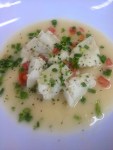





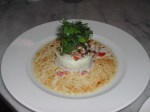









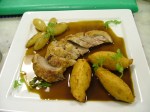
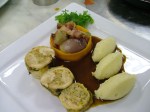

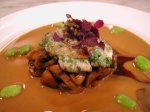

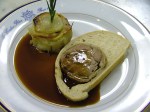



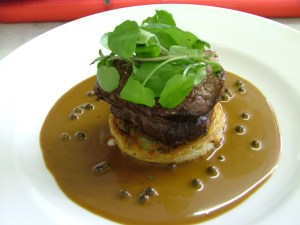

Pingback: Top 10 Best Hot Sauce to Buy in 2022-23 - NewCommReview
Pingback: Is It Safe To Leave Beef Stroganoff Out Overnight? – Euro Food Seattle
Pingback: How To Make A Quick And Easy Cream Sauce With Olive Oil – LittleKitchenBigWorld
Pingback: How To Add Lemon To Cream Sauce Without Curdling It – LittleKitchenBigWorld
Pingback: How To Make A Creamy Mustard Sauce In Minutes! – LittleKitchenBigWorld
Pingback: Perfect Pairing: Should You Heat Marinara Sauce for Mozzarella Sticks? | aNewYorkFoodie.com